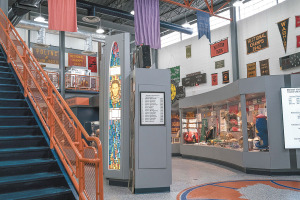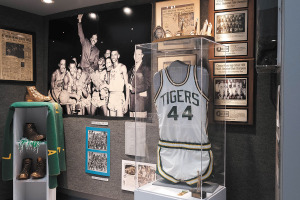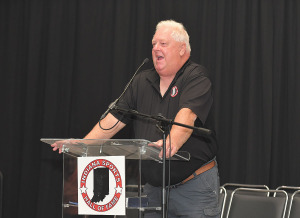Subscriber Benefit
As a subscriber you can listen to articles at work, in the car, or while you work out. Subscribe Now It seems there’s a hall of fame for everyone these days, and if you’re not in one already, there’s always the option of starting your own and inducting yourself. All it takes is a website.
It seems there’s a hall of fame for everyone these days, and if you’re not in one already, there’s always the option of starting your own and inducting yourself. All it takes is a website.
That’s especially true in the sports world. Virtually every high school and university in Indiana has a sports hall of fame. Some cities, counties and regions have one. And, certainly, most sports honor their elite athletes, coaches and other contributors in some manner.
Making a hall of fame work as a business and/or charitable enterprise is an entirely different matter. In Indiana, there are halls of fame for just about every sport, but only three have a physical location with visiting hours. That would be the Indiana Basketball Hall of Fame in New Castle, the Indiana Track & Field and Cross Country Hall of Fame Museum in Terre Haute and the Indiana Baseball Hall of Fame in Jasper.
Not that the honorees in the virtual “halls” should feel diminished. The recognition is the same whether the public can go somewhere to look at a plaque on a wall or jersey in a display case. And nobody can be blamed for not sprouting a museum given all the challenges of keeping the doors open.
What do the museum halls have that the website halls don’t?
Simple. Sugar daddies. Plenty of volunteer help, too.
The state’s largest and most historic hall of fame museum, to no surprise, is the one for basketball in New Castle. It opened there in 1990 after three decades of near anonymity in a 10,000-square-foot facility that had become inadequate under the weight of the constant stream of donated items. An addition of 6,600 square feet is under construction, scheduled to open in October.
“We’ve had people from Minnesota stop in and say, ‘We want to do this; how do we do it?’” Executive Director Matt Martin said.
His answer: “Get lucky. Find people who want to back it.”
Danny Danielson is the basketball hall’s primary “daddy,” donating the land for the current building and helping fund other projects. A Henry County food and beverage tax helps, too, and the hall raises funds through three summer golf outings, the men’s and women’s induction banquets, the two-day Hall of Fame Classic high school games at New Castle High School and membership dues.
Admission income is minimal, with adults charged $5, and youths and senior citizens less. Individuals in groups pay just $1 each. “The most we’ve ever had in a year is about $12,000,” Martin said.
Scraping by
If the basketball hall is that reliant on charity, you can imagine what the other sports face. The hall of fame for the state’s second-most popular sport, football, had to go virtual once the pandemic hit in 2020, crippling its already struggling museum.
The Indiana Football Hall of Fame opened in a former post office in Richmond in 1974 after four men took out second mortgages on their homes to finance it. Scott Bovenkerk, the current coordinator of the hall, which is governed by the Indiana Football Coaches Association, understands the challenge it was facing as well as anyone. He was inducted in 2010 but wasn’t inclined to make regular trips from his home in South Bend to visit.


“You might go once to see your plaque and picture on the wall, but how many times are you going to make that trip?” he said. “Now that it’s virtual, we get more than a hundred hits on our website every day. More people are viewing our website than made the trip to Richmond.”
The building that housed the museum was sold to a Richmond bank, and the plaques and other memorabilia were distributed to the schools of the inductees. The “hall” is now divided into 10 geographic regions, each with its own chair and committee. There’s a formal process for nominations, and each region is permitted to add three members annually.
Regional induction ceremonies have been conducted everywhere from well-attended banquets to barns to the Harley Davidson store in Fishers.
“It’s whatever works best for that community and for that inductee,” Bovenkerk said.
The difficulty of maintaining any hall of fame museum was further demonstrated to Bovenkerk when he volunteered to work at the national College Football Hall of Fame in South Bend.
“It was a gorgeous museum, but few people came,” he said. “I worked Tuesday nights from 6 to 9, and most of the time, I never saw a soul.” The hall now resides in Atlanta.
Indianapolis housed the National Track and Field Hall of Fame from 1986 to 1996, but it, too, moved on. It now resides in New York City. The state’s track and field and cross country hall of fame, however, has survived thanks to the largesse of businessman Greg Gibson, a Gerstmeyer High School and Rose-Hulman Institute of Technology graduate.
The museum, which opened in 2011, also has a favorable deal with the Terre Haute Convention and Visitors Bureau. It pays rent but doesn’t have to cover utilities, which enables it to accept donations but not charge admission.
“We want kids to come in and learn about track and field,” Director Marshall Goss said. “We go dollar by dollar. If we get a few dollars, we put it into something different.”
The hall has a wide range of exhibits and memorabilia, such as a 400-pound trophy awarded to Manual High School for winning the state cross country meet and a bronze medal won by pole vaulter Ed Glover in the 1906 Olympics. Another Olympian from Indiana—one of 51—has it in his will to donate his gold medal. An exhibit showing the nine different surfaces that have been used for running tracks recently opened.
Volunteers are a must
They’ll also have to continue relying on volunteer help, as all halls do to varying degrees. Even the virtual halls need people to handle tasks such as maintaining the website (many could use updating) and organizing induction banquets. The halls with physical facilities are a much greater challenge.
“It’s just difficult,” Goss said. “We have about nine people that show up nearly every Wednesday and go over different things.”
The state’s baseball hall of fame, which began inducting members in 1979, landed a home on the Vincennes University campus in Jasper in 1991. It owes its existence mostly to local businessman Alvin Ruxer, who provided the initial funding, and is operated by the Indiana High School Baseball Coaches Association. Again, admission income barely factors into its survival—tickets range from $2 to $4. Donations and a fundraising golf tournament provide much of the annual income.
“As far as we know, we’re the only baseball coaches’ association in the country that has their own [physical] hall of fame,” Executive Director Ray Howard said. “Everybody else has [just] walls and hallways.”
Howard said the baseball hall was initially planned for Indianapolis, but nobody took charge. He admits Jasper, 120 miles south of Indianapolis, isn’t the ideal location.
“We’re hard to find,” he said. “There’s no easy way to get to Jasper. Although people do it.”
He considers the hall a “hidden treasure,” filled with memorabilia from Major League Baseball players with state ties and others. It relies mostly on word-of-mouth advertising.
“People who go through are happy with what they see,” Howard said. “They say, ‘I had no idea you had all of this here.’”
There’s also an Indiana Boxing Hall of Fame in Vevay, although its website lists no address or visiting hours. It was formed in 2018 and opened a museum of about 4,000 square feet adjacent to a gym within the Switzerland County Fairgrounds in 2020. It charges no admission and pays no rent. Dave Hyatt is the primary backer, with help from founder and CEO Craig Houk, who initiated the museum with memorabilia he had gathered throughout his career as a boxer.
“I needed to find a place for it so my stuff wouldn’t be stolen,” he said.
If you want to see it, Houk said, call Hyatt and perhaps he can meet you there.
The hall has inducted nationally known boxers with loose Indiana ties, including Muhammad Ali. His wife attended last year’s ceremony.
“The goal is to go 10 years,” Houk said. “It takes unbelievable organizational skills. It takes money, time and effort.”
A pipe dream?
And space. The state high school swimming and diving hall of fame has a home on the concourse level of the IU Natatorium. The state tennis hall, meanwhile, will soon be open on the North Central High School campus. It will have a digital touch screen displaying its inductees and history in the tennis building.
Tim Turpin doesn’t need to be told of the challenge of establishing a public facility. He’s leading what is essentially a one-man effort to establish an all-inclusive Indiana Sports Hall of Fame in Evansville. He got the idea while traveling the country as the owner of a company that makes commemorative bricks and realizing other states had such halls. The pandemic negated his plan for an inaugural induction banquet in April 2021, so he brought in two classes virtually in December 2020. He conducted his first public induction in May 2022 and had a second in August 2023; both were in Evansville. He’s admitted 540 people with an Indiana sports connection so far and will bring in another class this July.

His induction banquets have attracted hundreds of guests, including NBA coach Del Harris; baseball pitchers Tommy John and Andy Benes; NFL receiver Mark Clayton; former Indiana State University and NBA guard Carl Nicks; and former Mr. Basketballs Kent Benson, Kyle Macy and David Magley.
He has a floor plan on his organization’s website for a 40,000-square-foot facility. The trick is finding the funds. He is hopeful a Florida group planning to build a resort in the Evansville area will provide space and that someone with sugar-filled pockets will emerge to support his dream. He’ll feel more comfortable approaching donors if he has proof of a facility to house such a massive effort but needs a major donation or act of charity to get one—a classic chicken-and-egg conundrum. Meanwhile, he says he’s put about $10,000 of his own money into promoting the effort.
He hopes to combine it with two other halls he has founded—the National Semi-Pro Baseball Hall of Fame and the Greater Evansville Sports Hall of Fame.
“We would be further along if COVID hadn’t hit,” he said. “At some point, we’re going to get this ground, and this thing will exist. I’m only 55. I’m not going to stop.”•
__________
Montieth, an Indianapolis native, is a longtime newspaper reporter and freelance writer. He is the author of three books: “Passion Play: Coach Gene Keady and the Purdue Boilermakers,” “Reborn: The Pacers and the Return of Pro Basketball to Indianapolis,” and “Extra Innings: My Life in Baseball,” with former Indianapolis Indians President Max Schumacher.
Please enable JavaScript to view this content.

Where are you, Jim Irsey? Herb Simon?